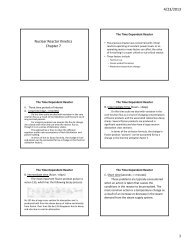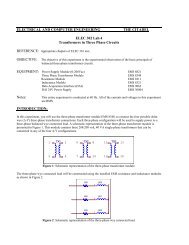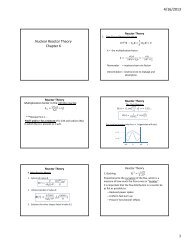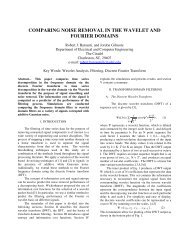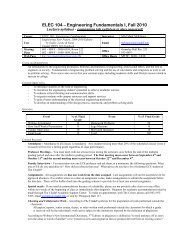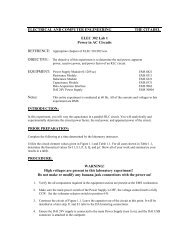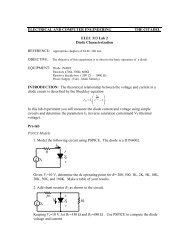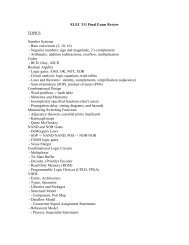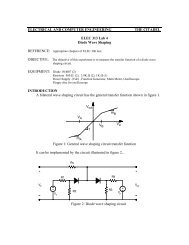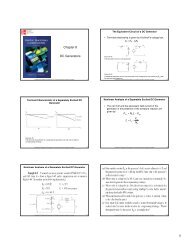Neutron Diffusion & Moderation Chapter 5
Neutron Diffusion & Moderation Chapter 5
Neutron Diffusion & Moderation Chapter 5
Create successful ePaper yourself
Turn your PDF publications into a flip-book with our unique Google optimized e-Paper software.
3/15/2013<br />
<strong>Neutron</strong> <strong>Diffusion</strong> & <strong>Moderation</strong><br />
<strong>Chapter</strong> 5<br />
<strong>Neutron</strong> <strong>Diffusion</strong> and <strong>Moderation</strong><br />
How are neutrons distributed throughout the reactor<br />
core?<br />
This is the fundamental question explaining the design<br />
and subsequent operation of the reactor.<br />
Unfortunately, determining the neutron distribution is a<br />
difficult problem. An approximation can be arrived at<br />
by solving the diffusion equation. This differential<br />
equation describes how high concentration solute<br />
diffuses to regions of lower concentration. This is<br />
similar to how neutrons behave in a reactor.<br />
<strong>Neutron</strong> <strong>Diffusion</strong> and <strong>Moderation</strong><br />
The diffusion equation is found as the combination of<br />
two laws of physics;<br />
1. Fick’s law of diffusion<br />
2. Equation of continuity<br />
Fick’s Law<br />
<strong>Neutron</strong> <strong>Diffusion</strong> and <strong>Moderation</strong><br />
= − ∅<br />
<br />
J x – The neutron current density is the net # of neutrons that<br />
pass per unit time through a unit area perpendicular to the x<br />
<br />
direction. J x has the same units as flux φ. {<br />
}<br />
D – the diffusion coefficient in units of m or cm.<br />
∅()<br />
<br />
x<br />
If there is a negative<br />
flux gradient, then<br />
there is a net flow of<br />
neutrons along the<br />
positive x direction.<br />
<strong>Neutron</strong> <strong>Diffusion</strong> and <strong>Moderation</strong><br />
Fick’s Law<br />
Consider neutrons passing through the plane at x=0<br />
from left to right as the result of collisions to the left of<br />
the plane. Since the concentration of neutrons and the<br />
flux is larger for negative values of x, there are more<br />
collisions per cm 3 on the left. Therefore more neutrons<br />
are scattered from left to right, then the other way<br />
around. Thus the neutrons naturally diffuse toward the<br />
right.<br />
In general the flux and neutron current density are a<br />
function of 3 spatial variables so that the law is<br />
= −∅ = −∅<br />
Fick’s Law<br />
<strong>Neutron</strong> <strong>Diffusion</strong> and <strong>Moderation</strong><br />
= −∅ = −∅<br />
Recall = = <br />
, , = <br />
+ + ̂<br />
<br />
The grad of a scalar f(x, y, z) is a vector, whose<br />
components are equal to the rates of change of f<br />
along the component axes.<br />
1
3/15/2013<br />
<strong>Neutron</strong> <strong>Diffusion</strong> and <strong>Moderation</strong><br />
Ex… The flux at a distance r from a point source<br />
emitting S n/sec is given by ∅ = /<br />
where D<br />
and L are constants.<br />
a) Find expression for neutron current density vector J<br />
b) Find expression for # of neutrons flowing out of a<br />
sphere of radius r surrounding the source.<br />
-----------------------------------------------------------<br />
a) Because of the geometry, the current density vector<br />
must point outward in the r radial direction, thus the r<br />
component of the gradient is in spherical<br />
Ex (cont.)<br />
<strong>Neutron</strong> <strong>Diffusion</strong> and <strong>Moderation</strong><br />
So = − <br />
= <br />
<br />
= ∙ <br />
<br />
<br />
<br />
( <br />
= <br />
<br />
)/<br />
<br />
<br />
+ <br />
b) Area of sphere = 4 <br />
so,<br />
⁄<br />
<br />
<br />
<br />
= ∙ = (1 + ⁄<br />
) ⁄<br />
<br />
<br />
coordinates is = <br />
<strong>Neutron</strong> <strong>Diffusion</strong> and <strong>Moderation</strong><br />
It must be emphasized that Fick’s law is an<br />
approximation and is not valid under the following<br />
conditions;<br />
1. In a medium that strongly absorbs neutrons.<br />
2. Within ~3 mean free paths of either a neutron<br />
source or a surface of a medium boundary.<br />
3. When the scattering of neutrons is strongly<br />
anisotropic.<br />
To some extent, these limitations are valid in every<br />
practical reactor. Never the less Fick’s law gives a<br />
reasonable approximation. For more detailed<br />
calculations, higher order methods are available.<br />
<strong>Neutron</strong> <strong>Diffusion</strong> and <strong>Moderation</strong><br />
Equation of Continuity<br />
Is the mathematical statement that the time rate of<br />
change of neutrons in a volume V must be accounted<br />
for by means of absorption and leakage.<br />
[rate of change of n in V] =<br />
[rate of production of n’s in V]<br />
- [rate of absorption of n’s in V]<br />
- [rate of leakage of n’s in V]<br />
<strong>Neutron</strong> <strong>Diffusion</strong> and <strong>Moderation</strong><br />
Rate of change of neutrons<br />
If n = neutron density, then is the total<br />
<br />
number of neutrons in the volume V. The rate of<br />
change is <br />
<br />
<br />
(,,,)<br />
<br />
<br />
.<br />
, which can be written<br />
Absorption rate<br />
The rate (per second) at which neutrons are lost by<br />
absorption per ∑ ∅ {units =<br />
<br />
}.<br />
<br />
= ∑ ∅ <br />
∑<br />
<strong>Neutron</strong> <strong>Diffusion</strong> and <strong>Moderation</strong><br />
Leakage rate<br />
Since the dot product of the current density with the<br />
unit normal (u) to the surface { ∙ u } is the net number<br />
of neutrons passing outward through the surface.<br />
= ∙ <br />
<br />
This surface integral can be changed to a volume<br />
integral by use of the divergence theorem.<br />
∙ <br />
<br />
= <br />
<br />
2
3/15/2013<br />
<strong>Neutron</strong> <strong>Diffusion</strong> and <strong>Moderation</strong><br />
Divergence of a vector field<br />
Given a vector F (x,y,z)<br />
then<br />
= ∙ = <br />
+ <br />
+ <br />
.<br />
Which is a scalar valued function.<br />
<strong>Neutron</strong> <strong>Diffusion</strong> and <strong>Moderation</strong><br />
The equation of continuity thus becomes<br />
<br />
= <br />
− Σ ∅ − <br />
<br />
<br />
<br />
<br />
Since all of the integrals are carried out over the same<br />
volume, their integrands must be equal so,<br />
or<br />
<br />
<br />
<br />
<br />
= { − Σ ∅ − } <br />
<br />
<br />
= S − Σ ∅ − <br />
In steady state, when n is not a function of time,<br />
S − Σ ∅ − = 0<br />
<strong>Neutron</strong> <strong>Diffusion</strong> and <strong>Moderation</strong><br />
<strong>Diffusion</strong> Equation<br />
Ficks Law: J = −D∅ . 1<br />
.<br />
<br />
= − Σ ∅ − . 2<br />
<strong>Neutron</strong> <strong>Diffusion</strong> and <strong>Moderation</strong><br />
<strong>Diffusion</strong> Equation<br />
Where<br />
given by<br />
= div grad is called the Laplacian and is<br />
(, , ) = <br />
+ <br />
+ <br />
<br />
Eq. 2<br />
From Eq. 1<br />
So<br />
= − Σ ϕ − <br />
<br />
= − ∅ = − ∅<br />
∅ − Σ ∅ + = <br />
<br />
Since we will consider only time-independent problems<br />
The steady-state diffusion eqn. is given by:<br />
∅ − Σ ∅ + = 0<br />
<strong>Diffusion</strong> Equation<br />
Dividing by D we get:<br />
∅ − Σ ∅<br />
+ / = 0<br />
Define: = <br />
= diffusion area.<br />
And L = diffusion length in meters<br />
L is a measure of the average distance traveled by a<br />
<strong>Neutron</strong> prior to absorption. It is determined by<br />
the geometry and physical properties of the core.<br />
Ex…<br />
∅ − ∅ + / = 0<br />
5.3 Two point sources each emitting S {n/sec}, are<br />
located a distance 2a cm apart in an isotropic medium<br />
with diffusion constant D. Derive an expression for the<br />
flux φ and current density J at the midpoint P.<br />
-----------------------------------<br />
Solution --- a --- P --- a ---<br />
S1<br />
S2<br />
The flux φ is a scalar so, ∅ = ∅ 1 + ∅(2).<br />
∅ = /<br />
4 + /<br />
4 = /<br />
2<br />
The current densisty J(r) is a vector, and because the<br />
current vectors from each source are equal and<br />
opposite at point P, J(P) = 0.<br />
3
3/15/2013<br />
Solution to the <strong>Diffusion</strong> Equation for a point source<br />
Consider a small sphere point source emitting S<br />
neutrons per second into an isotropic medium.<br />
The spherical form of the Laplacian is<br />
= <br />
(<br />
<br />
<br />
EQ 4. <br />
= <br />
Solution to the <strong>Diffusion</strong> Equation for a point source<br />
So,<br />
<br />
= 0 has solution<br />
= / + /<br />
)+ ….. (see App III of text)<br />
<br />
thus<br />
<br />
∅ = / <br />
+ /<br />
<br />
<br />
∅ = /<br />
.<br />
<br />
The diffusion equation becomes (for r ≠ 0 )<br />
∅()<br />
− ∅ = 0 EQ. 3<br />
Let = ∅ , then (see aside notes) EQ. 3 becomes<br />
Since physical conditions dictate that φ remain finite as<br />
r increases, then = 0. So that<br />
To find C1 we use the fact that the current density J(r)<br />
through a small sphere (by simple geometry) must be<br />
Solution to the <strong>Diffusion</strong> Equation for a point source<br />
So, using Fick’s Law = − ∅<br />
, substituting<br />
Evaluating at r ->0 (where J(r) = S)and solving for S yields<br />
= lim<br />
→<br />
4 <br />
thus =<br />
<br />
4 = <br />
<br />
<br />
<br />
+ 1 / = 4 <br />
, and so finally<br />
1<br />
+ 1 / ASIDE<br />
∅() = /<br />
4<br />
Ex… 5.6 A point source emitting 10 7 {n/sec}, is located<br />
in an infinite body of unit density water at room<br />
temperature. What is the flux φ 15cm from the<br />
source?<br />
-----------------------------------<br />
Solution<br />
For a point source the flux φ is ∅ = /<br />
<br />
Using table 5.2: L = 2.85 cm, and D = 0.16 cm.<br />
∅ = 10 /.<br />
4 0.16 15 = <br />
1.7210 − <br />
Solution to the <strong>Diffusion</strong> Equation for a Infinite Plane<br />
Source.<br />
We have an infinite planar source at x = 0, emitting S n/s.<br />
There is no variation in ‘y’ or ‘z’ flux since plane is infinite<br />
in those directions. There are no source except at x = 0.<br />
4
3/15/2013<br />
Solution to the <strong>Diffusion</strong> Equation for a Infinite Plane<br />
Source.<br />
The diffusion equation becomes<br />
∅<br />
− 1 ∅ = 0 ≠ 0<br />
S (n/sec)<br />
x = 0<br />
Because of symmetry, we need only solve the equation<br />
in one-half of the plane. Then, by an appropriate<br />
transformation we can get the solution for the other<br />
half.<br />
Solution to the <strong>Diffusion</strong> Equation for a Infinite Plane<br />
Source.<br />
The general solution is<br />
∅ = / + /<br />
Since ∅′ = ⁄ / , ∅′′ = ⁄ /<br />
So,<br />
0 = ⁄ / + ⁄ /<br />
Considering the right half plane x > 0, then C2 = 0, since<br />
the φ can not increase without bound.<br />
So,<br />
∅ = /<br />
Solution to the <strong>Diffusion</strong> Equation for a Infinite Plane<br />
Source.<br />
To find C1 we use the source condition, and Ficks Law,<br />
= − ∅<br />
= <br />
<br />
/<br />
Imagine a unit area box constructed at the plane, the<br />
net flow of neutrons parallel to the plane source<br />
through the box is 2 J(x). Then at the surface of the<br />
plane, as the box shrinks to x = 0, the net flow of<br />
neutrons out of the box must be equal to S n/s.<br />
Thus,<br />
lim<br />
→<br />
2 ∙ = <br />
Solution to the <strong>Diffusion</strong> Equation for a Infinite Plane<br />
Source.<br />
So, lim = ⁄ = lim<br />
→<br />
Thus,<br />
<br />
→ <br />
= <br />
<br />
/ = <br />
<br />
And, ∅ = <br />
for x >0<br />
and by symmetry,<br />
So,<br />
∅ − = <br />
() for x



